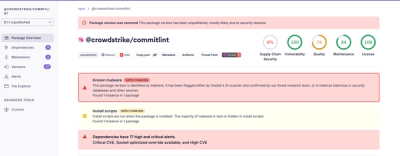
Research
Malicious fezbox npm Package Steals Browser Passwords from Cookies via Innovative QR Code Steganographic Technique
A malicious package uses a QR code as steganography in an innovative technique.
The original repository stop maintenance. This is a transfer version
pylcs is a super fast c++ library which adopts dynamic programming(DP) algorithm to solve two classic LCS problems as below .
The longest common subsequence problem is the problem of finding the longest subsequence common to all sequences in a set of sequences (often just two sequences).
The longest common substring problem is to find the longest string (or strings) that is a substring (or are substrings) of two or more strings.
Levenshtein distance, aka edit distance is also supported. Emm...forget the package name. Example usage is in tests.
We also support Chinese(or any UTF-8) string.
Colorful Visualization: After 0.1.0, you can visualize the lcs result with colorful output.
To install, simply do pip install pylcs to pull down the latest version from PyPI.
import pylcs
# finding the longest common subsequence length of string A and string B
A = 'We are shannonai'
B = 'We like shannonai'
pylcs.lcs_sequence_length(A, B)
"""
>>> pylcs.lcs_sequence_length(A, B)
14
"""
# finding alignment from string A to B
A = 'We are shannonai'
B = 'We like shannonai'
res = pylcs.lcs_sequence_idx(A, B)
''.join([B[i] for i in res if i != -1])
"""
>>> res
[0, 1, 2, -1, -1, 6, 7, 8, 9, 10, 11, 12, 13, 14, 15, 16]
>>> ''.join([B[i] for i in res if i != -1])
'We e shannonai'
"""
# finding the longest common subsequence length of string A and a list of string B
A = 'We are shannonai'
B = ['We like shannonai', 'We work in shannonai', 'We are not shannonai']
pylcs.lcs_sequence_of_list(A, B)
"""
>>> pylcs.lcs_sequence_of_list(A, B)
[14, 14, 16]
"""
# finding the longest common substring length of string A and string B
A = 'We are shannonai'
B = 'We like shannonai'
pylcs.lcs_string_length(A, B)
"""
>>> pylcs.lcs_string_length(A, B)
11
"""
# finding alignment from string A to B
A = 'We are shannonai'
B = 'We like shannonai'
res = pylcs.lcs_string_idx(A, B)
''.join([B[i] for i in res if i != -1])
"""
>>> res
[-1, -1, -1, -1, -1, 6, 7, 8, 9, 10, 11, 12, 13, 14, 15, 16]
>>> ''.join([B[i] for i in res if i != -1])
'e shannonai'
"""
# finding the longest common substring length of string A and a list of string B
A = 'We are shannonai'
B = ['We like shannonai', 'We work in shannonai', 'We are not shannonai']
pylcs.lcs_string_of_list(A, B)
"""
>>> pylcs.lcs_string_of_list(A, B)
[11, 10, 10]
"""
# finding the weighted edit distance from string A to B
pylcs.edit_distance("aaa", "aba")
pylcs.edit_distance("aaa", "aba", {'a': {'b': 2.0}})
pylcs.edit_distance("", "aa", {'': {'a': 0.5}})
# weight['']['a'] means inserting a char 'a' costs 0.5
# similarly, weight['a'][''] means the score of deleting a char 'a'
"""
>>> pylcs.edit_distance("aaa", "aba")
1
>>> pylcs.edit_distance("aaa", "aba", {'a': {'b': 2.0}})
2.0
>>> pylcs.edit_distance("", "aa", {'': {'a': 0.5}})
1.0
"""
# finding edit distance alignment from string A to B
pylcs.edit_distance_idx("aaa", "aba")
pylcs.edit_distance_idx("aaa", "aba", {'a': {'b': 3}})
pylcs.edit_distance_idx("aa", "aabb", {'a': {'a': 2, 'b': 0}})
"""
>>> pylcs.edit_distance_idx("aaa", "aba")
[0, 1, 2]
>>> pylcs.edit_distance_idx("aaa", "aba", {'a': {'b': 3}})
[0, -1, 2]
>>> pylcs.edit_distance_idx("aa", "aabb", {'a': {'a': 2, 'b': 0}})
[2, 3]
"""
After 0.1.0, you can make a visualized comparison with colorful output. Using coloring_match_sequence to color the s1 and s2 by a match list like:
s1, s2 = "abcdefghijklmnopq", "-c-fgh-kl-nop-q"
match_list = pylcs.lcs_sequence_idx(s1, s2)
colored_s1, colored_s2 = pylcs.coloring_match_sequence(match_list, s1, s2, 11, 11, "#2266ff", "#2266ff", t=1)
print(colored_s1, colored_s2)
colored_s1, colored_s2 = pylcs.coloring_match_sequence(match_list, s1, s2, 11, 11, "#2266ff", "#2266ff", t=2)
print(colored_s1, colored_s2)
colored_s1, colored_s2 = pylcs.coloring_match_sequence(match_list, s1, s2, 11, 11, "#2266ff", "#2266ff", t=3)
print(colored_s1, colored_s2)

s1, s2 = "How does this string edit to s2?", "How similar is this string to s1?"
match_list = pylcs.edit_distance_idx(s1, s2)
colored_s1, colored_s2 = pylcs.coloring_match_sequence(match_list, s1, s2, 4, 4, 230, 230, t=2)
print(colored_s1, colored_s2, sep='\n')

Note that the colorful output uses ANSI escape codes. Referring to https://en.wikipedia.org/wiki/ANSI_escape_code.
The ANSI codes may not work in win32 command line.
FAQs
super fast cpp implementation of longest common subsequence
We found that pylcs demonstrated a healthy version release cadence and project activity because the last version was released less than a year ago. It has 1 open source maintainer collaborating on the project.
Did you know?

Socket for GitHub automatically highlights issues in each pull request and monitors the health of all your open source dependencies. Discover the contents of your packages and block harmful activity before you install or update your dependencies.

Research
A malicious package uses a QR code as steganography in an innovative technique.

Research
/Security News
Socket identified 80 fake candidates targeting engineering roles, including suspected North Korean operators, exposing the new reality of hiring as a security function.

Application Security
/Research
/Security News
Socket detected multiple compromised CrowdStrike npm packages, continuing the "Shai-Hulud" supply chain attack that has now impacted nearly 500 packages.